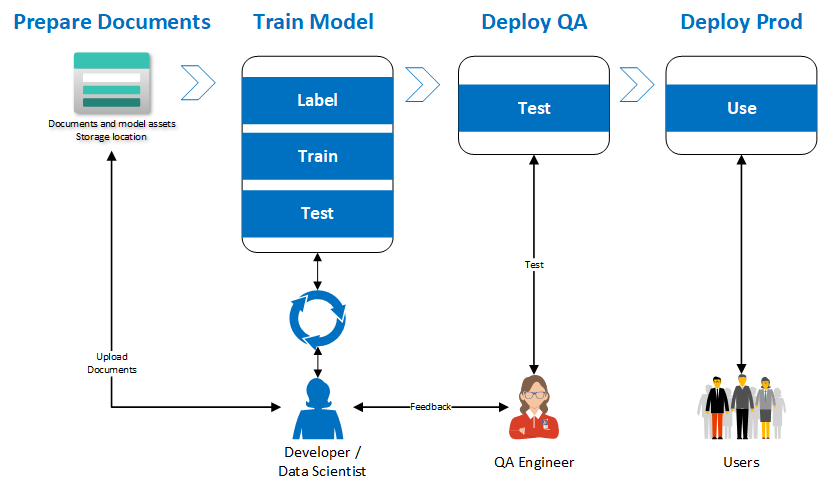
by Contributed | Feb 27, 2022 | Technology
This article is contributed. See the original author and article here.
Introduction
Azure Form Recognizer is an amazing Azure AI Service to extract and analyze form fields documents. One benefit of using Form Recognizer is the ability to create your own custom model based on documents specific to your business needs.
To create custom models, Azure provides Form Recognizer Studio, a web application that makes creation and training of custom model simple without the needs of an AI expert.
One common challenge most customers have when dealing with more than a handful of models is to apply the same DevOps processes, they are familiar with when promoting code changes from one environment to another to their AI models.
This article demonstrates the use of Form Recognizer’s REST APIs to implement a CI/CD pipeline for model management.
The complete implementation is available on Github.
Why DevOps matters
When creating a custom model based on documents that map your business needs, your programmers and data scientists will go through multiple iterations of training, resulting in multiple different models in the development environment. Once they have a model that works well for the specific scenario, this model will then need to be promoted to other environments.
While it is possible to copy the training dataset and train a model in all of the other environments, that process is cumbersome and can result in missed labels resulting in lower accuracy models. A more effective approach is to treat the model like a source code artifact and use a DevOps pipeline to orchestrate the movement of the model across the different environments ensuring traceability and compliance. The diagram below explains the proposed implementation flow to achieve this result.

Our implementation
For our use case, let’s assume we have three environments: each is in a respective resource group. This approach would work even if the resource groups are in three different subscriptions.

The model is trained in the development environment, where , data scientists and/or developers will use the Form Recognizer Studio to label the documents in a storage account. The following steps describe that process in greater detail.
Start by moving the training dataset to a specific container in Azure Blob Storage.
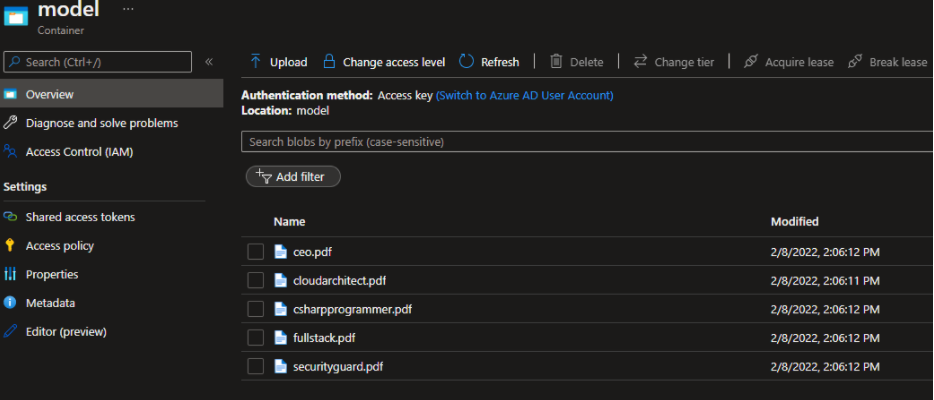
In the Form Recognizer Studio, start by creating a custom project and connecting the Studio to work with the dataset, you just created.
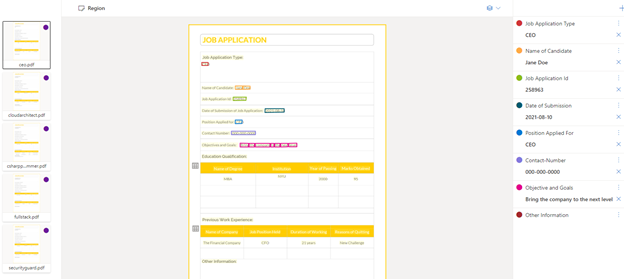
When you train your model, be sure to save the model ID you provided or find the model from the list of models within the project. This model ID will be needed when it’s time to migrate the model to other environments.

Form Recognizer provides a model copy operation that starts with generating a model copy authorization for the target resource, in this case the QA environment. This copy automation is provided to the Form Recognizer development resource to then execute the copy action.
To orchestrate this set of actions, a simple GitHub action was created. The API can be integrated into your CI/CD pipeline using REST or any of the language specific SDKs. In this case, we created an Azure Function that uses the .NET SDK for Form Recognizer. This Azure Function provides multiple endpoints that are leveraged in the GitHub Action.

The following diagram describes the GitHub Actions Orchestration.
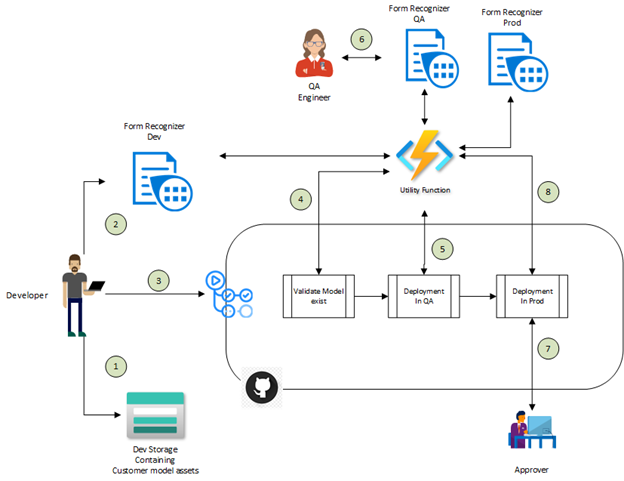
- The developer moves all the documents needed to train the custom model into Azure Storage account.
- The developer uses the Form Recognizer Studio to train the custom model in the development environment. Once the model is trained and the developer is satisfied with the model quality, the model ID is saved for use with the GitHub action.
- The developer initiates the GitHub action by providing the model ID from the previous step as an input parameter.
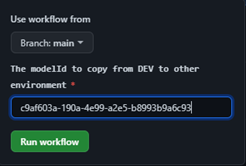
- The first step is to validate that the model ID exists in the DEV environment.

- If the model exists in the DEV environment, it will be copied to the QA environment
- Now, a QA engineer can validate the model produces the expected results.
- Once the QA tests are successful, an approver needs to approve the next job to promote the model to the production environment.
- The model is now copied to the production environment and is available for use.
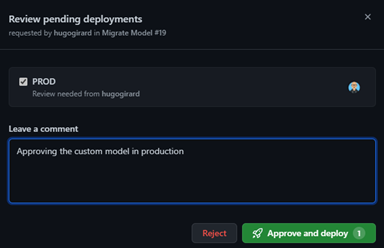

Once the model is in production, you can use it within your applications. The following example demonstrates how the model is being used to analyze documents.
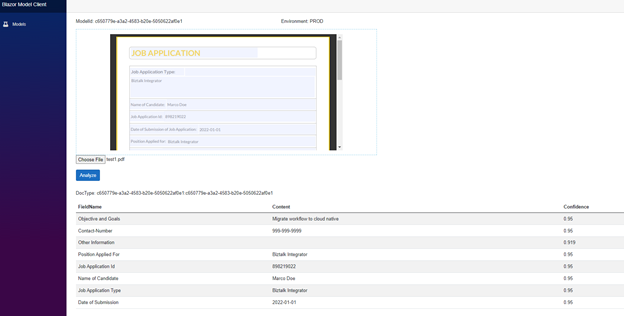
Here are the GitHub Action used in this sample, it consists of 3 jobs that invoke the Azure Function using a PowerShell script. As stated earlier, the Azure Function implementation is optional, this could be accomplished via HTTP requests directly to the Form Recognizer resources from your pipelines.
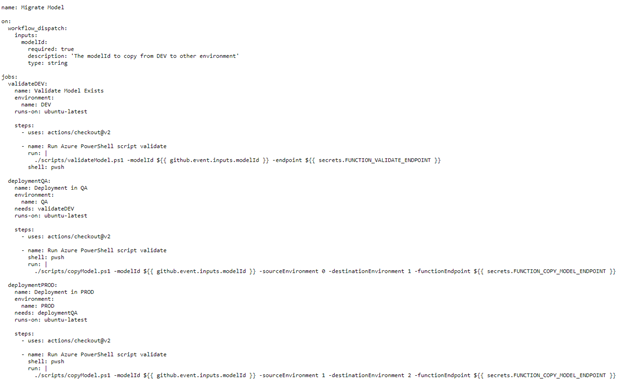
Here is the simple PowerShell script.
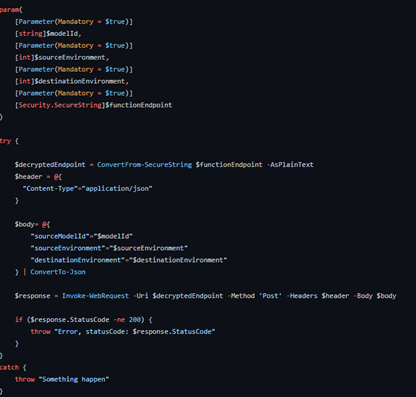
Conclusion
In this blog post, we explain the importance of implementing a DevOps practice around your custom models in Azure Form Recognizer. We provide an implementation and illustrate how easy it is to implement with the REST API.
by Scott Muniz | Feb 26, 2022 | Security, Technology
This article is contributed. See the original author and article here.
CISA and the Federal Bureau of Investigation have released an advisory on destructive malware targeting organizations in Ukraine. The advisory also provides recommendations and strategies to prepare for and respond to destructive malware.
Additionally, CISA has created a new Shields Up Technical Guidance webpage that details other malicious cyber activity affecting Ukraine. The webpage includes technical resources from partners to assist organizations against these threats.
CISA recommends organizations review Destructive Malware Targeting Organizations in Ukraine and Shields Up Technical Guidance webpage for more information.
by Scott Muniz | Feb 26, 2022 | Security, Technology
This article is contributed. See the original author and article here.
Summary
Actions to Take Today:
• Set antivirus and antimalware programs to conduct regular scans.
• Enable strong spam filters to prevent phishing emails from reaching end users.
• Filter network traffic.
• Update software.
• Require multifactor authentication.
Leading up to Russia’s unprovoked attack against Ukraine, threat actors deployed destructive malware against organizations in Ukraine to destroy computer systems and render them inoperable.
- On January 15, 2022, the Microsoft Threat Intelligence Center (MSTIC) disclosed that malware, known as WhisperGate, was being used to target organizations in Ukraine. According to Microsoft, WhisperGate is intended to be destructive and is designed to render targeted devices inoperable.
- On February 23, 2022, several cybersecurity researchers disclosed that malware known as HermeticWiper was being used against organizations in Ukraine. According to SentinelLabs, the malware targets Windows devices, manipulating the master boot record, which results in subsequent boot failure.
Destructive malware can present a direct threat to an organization’s daily operations, impacting the availability of critical assets and data. Further disruptive cyberattacks against organizations in Ukraine are likely to occur and may unintentionally spill over to organizations in other countries. Organizations should increase vigilance and evaluate their capabilities encompassing planning, preparation, detection, and response for such an event.
This joint Cybersecurity Advisory (CSA) between the Cybersecurity and Infrastructure Security Agency (CISA) and Federal Bureau of Investigation (FBI) provides information on WhisperGate and HermeticWiper malware as well as open-source indicators of compromise (IOCs) for organizations to detect and prevent the malware. Additionally, this joint CSA provides recommended guidance and considerations for organizations to address as part of network architecture, security baseline, continuous monitoring, and incident response practices.
Click here for a PDF version of this report.
Technical Details
Threat actors have deployed destructive malware, including both WhisperGate and HermeticWiper, against organizations in Ukraine to destroy computer systems and render them inoperable. Listed below are high-level summaries of campaigns employing the malware. CISA recommends organizations review the resources listed below for more in-depth analysis and see the Mitigation section for best practices on handling destructive malware.
On January 15, 2022, Microsoft announced the identification of a sophisticated malware operation targeting multiple organizations in Ukraine. The malware, known as WhisperGate, has two stages that corrupts a system’s master boot record, displays a fake ransomware note, and encrypts files based on certain file extensions. Note: although a ransomware message is displayed during the attack, Microsoft highlighted that the targeted data is destroyed, and is not recoverable even if a ransom is paid. See Microsoft’s blog on Destructive malware targeting Ukrainian organizations for more information and see the IOCs in table 1.
Table 1: IOCs associated with WhisperGate
On February 23, 2022, cybersecurity researchers disclosed that malware known as HermeticWiper was being used against organizations in Ukraine. According to SentinelLabs, the malware targets Windows devices, manipulating the master boot record and resulting in subsequent boot failure. Note: according to Broadcom, “[HermeticWiper] has some similarities to the earlier WhisperGate wiper attacks against Ukraine, where the wiper was disguised as ransomware.” See the following resources for more information and see the IOCs in table 2 below.
Table 2: IOCs associated with HermeticWiper
| Name |
File Category |
File Hash |
Source |
| Win32/KillDisk.NCV |
Trojan |
912342F1C840A42F6B74132F8A7C4FFE7D40FB77
61B25D11392172E587D8DA3045812A66C3385451
|
ESET research |
| HermeticWiper |
Win32 EXE |
912342f1c840a42f6b74132f8a7c4ffe7d40fb77 |
SentinelLabs
|
| HermeticWiper |
Win32 EXE |
61b25d11392172e587d8da3045812a66c3385451 |
SentinelLabs
|
| RCDATA_DRV_X64 |
ms-compressed |
a952e288a1ead66490b3275a807f52e5 |
SentinelLabs
|
| RCDATA_DRV_X86 |
ms-compressed |
231b3385ac17e41c5bb1b1fcb59599c4 |
SentinelLabs
|
| RCDATA_DRV_XP_X64 |
ms-compressed |
095a1678021b034903c85dd5acb447ad |
SentinelLabs
|
| RCDATA_DRV_XP_X86 |
ms-compressed |
eb845b7a16ed82bd248e395d9852f467 |
SentinelLabs
|
| Trojan.Killdisk |
Trojan.Killdisk |
1bc44eef75779e3ca1eefb8ff5a64807dbc942b1e4a2672d77b9f6928d292591 |
Symantec Threat Hunter Team |
| Trojan.Killdisk |
Trojan.Killdisk |
0385eeab00e946a302b24a91dea4187c1210597b8e17cd9e2230450f5ece21da |
Symantec Threat Hunter Team |
| Trojan.Killdisk |
Trojan.Killdisk |
a64c3e0522fad787b95bfb6a30c3aed1b5786e69e88e023c062ec7e5cebf4d3e |
Symantec Threat Hunter Team |
| Ransomware |
Trojan.Killdisk |
4dc13bb83a16d4ff9865a51b3e4d24112327c526c1392e14d56f20d6f4eaf382 |
Symantec Threat Hunter Team |
Mitigations
Best Practices for Handling Destructive Malware
As previously noted above, destructive malware can present a direct threat to an organization’s daily operations, impacting the availability of critical assets and data. Organizations should increase vigilance and evaluate their capabilities, encompassing planning, preparation, detection, and response, for such an event. This section is focused on the threat of malware using enterprise-scale distributed propagation methods and provides recommended guidance and considerations for an organization to address as part of their network architecture, security baseline, continuous monitoring, and incident response practices.
CISA and the FBI urge all organizations to implement the following recommendations to increase their cyber resilience against this threat.
Potential Distribution Vectors
Destructive malware may use popular communication tools to spread, including worms sent through email and instant messages, Trojan horses dropped from websites, and virus-infected files downloaded from peer-to-peer connections. Malware seeks to exploit existing vulnerabilities on systems for quiet and easy access.
The malware has the capability to target a large scope of systems and can execute across multiple systems throughout a network. As a result, it is important for organizations to assess their environment for atypical channels for malware delivery and/or propagation throughout their systems. Systems to assess include:
- Enterprise applications – particularly those that have the capability to directly interface with and impact multiple hosts and endpoints. Common examples include:
- Patch management systems,
- Asset management systems,
- Remote assistance software (typically used by the corporate help desk),
- Antivirus (AV) software,
- Systems assigned to system and network administrative personnel,
- Centralized backup servers, and
- Centralized file shares.
While not only applicable to malware, threat actors could compromise additional resources to impact the availability of critical data and applications. Common examples include:
- Centralized storage devices
- Potential risk – direct access to partitions and data warehouses.
- Network devices
- Potential risk – capability to inject false routes within the routing table, delete specific routes from the routing table, remove/modify, configuration attributes, or destroy firmware or system binaries—which could isolate or degrade availability of critical network resources.
Best Practices and Planning Strategies
Common strategies can be followed to strengthen an organization’s resilience against destructive malware. Targeted assessment and enforcement of best practices should be employed for enterprise components susceptible to destructive malware.
Communication Flow
- Ensure proper network segmentation.
- Ensure that network-based access control lists (ACLs) are configured to permit server-to-host and host-to-host connectivity via the minimum scope of ports and protocols and that directional flows for connectivity are represented appropriately.
- Communications flow paths should be fully defined, documented, and authorized.
- Increase awareness of systems that can be used as a gateway to pivot (lateral movement) or directly connect to additional endpoints throughout the enterprise.
- Ensure that these systems are contained within restrictive Virtual Local Area Networks (VLANs), with additional segmentation and network access controls.
- Ensure that centralized network and storage devices’ management interfaces reside on restrictive VLANs.
- Layered access control, and
- Device-level access control enforcement – restricting access from only pre-defined VLANs and trusted IP ranges.
Access Control
- For enterprise systems that can directly interface with multiple endpoints:
- Require multifactor authentication for interactive logons.
- Ensure that authorized users are mapped to a specific subset of enterprise personnel.
- If possible, the “Everyone,” “Domain Users,” or the “Authenticated Users” groups should not be permitted the capability to directly access or authenticate to these systems.
- Ensure that unique domain accounts are used and documented for each enterprise application service.
- Context of permissions assigned to these accounts should be fully documented and configured based upon the concept of least privilege.
- Provides an enterprise with the capability to track and monitor specific actions correlating to an application’s assigned service account.
- If possible, do not grant a service account with local or interactive logon permissions.
- Service accounts should be explicitly denied permissions to access network shares and critical data locations.
- Accounts that are used to authenticate to centralized enterprise application servers or devices should not contain elevated permissions on downstream systems and resources throughout the enterprise.
- Continuously review centralized file share ACLs and assigned permissions.
- Restrict Write/Modify/Full Control permissions when possible.
Monitoring
- Audit and review security logs for anomalous references to enterprise-level administrative (privileged) and service accounts.
- Failed logon attempts,
- File share access, and
- Interactive logons via a remote session.
- Review network flow data for signs of anomalous activity, including:
- Connections using ports that do not correlate to the standard communications flow associated with an application,
- Activity correlating to port scanning or enumeration, and
- Repeated connections using ports that can be used for command and control purposes.
- Ensure that network devices log and audit all configuration changes.
- Continually review network device configurations and rule sets to ensure that communications flows are restricted to the authorized subset of rules.
File Distribution
- When deploying patches or AV signatures throughout an enterprise, stage the distributions to include a specific grouping of systems (staggered over a pre-defined period).
- This action can minimize the overall impact in the event that an enterprise patch management or AV system is leveraged as a distribution vector for a malicious payload.
- Monitor and assess the integrity of patches and AV signatures that are distributed throughout the enterprise.
- Ensure updates are received only from trusted sources,
- Perform file and data integrity checks, and
- Monitor and audit – as related to the data that is distributed from an enterprise application.
System and Application Hardening
- Ensure robust vulnerability management and patching practices are in place.
- CISA maintains a living catalog of known exploited vulnerabilities that carry significant risk to federal agencies as well as public and private sectors entities. In addition to thoroughly testing and implementing vendor patches in a timely—and, if possible, automated— manner, organizations should ensure patching of the vulnerabilities CISA includes in this catalog.
- Ensure that the underlying operating system (OS) and dependencies (e.g., Internet Information Services [IIS], Apache, Structured Query Language [SQL]) supporting an application are configured and hardened based upon industry-standard best practice recommendations. Implement application-level security controls based on best practice guidance provided by the vendor. Common recommendations include:
- Use role-based access control,
- Prevent end-user capabilities to bypass application-level security controls,
- For example, do not allow users to disable AV on local workstations.
- Remove, or disable unnecessary or unused features or packages, and
- Implement robust application logging and auditing.
Recovery and Reconstitution Planning
A business impact analysis (BIA) is a key component of contingency planning and preparation. The overall output of a BIA will provide an organization with two key components (as related to critical mission/business operations):
- Characterization and classification of system components, and
- Interdependencies.
Based upon the identification of an organization’s mission critical assets (and their associated interdependencies), in the event that an organization is impacted by destructive malware, recovery and reconstitution efforts should be considered.
To plan for this scenario, an organization should address the availability and accessibility for the following resources (and should include the scope of these items within incident response exercises and scenarios):
- Comprehensive inventory of all mission critical systems and applications:
- Versioning information,
- System/application dependencies,
- System partitioning/storage configuration and connectivity, and
- Asset owners/points of contact.
- Contact information for all essential personnel within the organization,
- Secure communications channel for recovery teams,
- Contact information for external organizational-dependent resources:
- Communication providers,
- Vendors (hardware/software), and
- Outreach partners/external stakeholders
- Service contract numbers – for engaging vendor support,
- Organizational procurement points of contact,
- Optical disc image (ISO)/image files for baseline restoration of critical systems and applications:
- OS installation media,
- Service packs/patches,
- Firmware, and
- Application software installation packages.
- Licensing/activation keys for OS and dependent applications,
- Enterprise network topology and architecture diagrams,
- System and application documentation,
- Hard copies of operational checklists and playbooks,
- System and application configuration backup files,
- Data backup files (full/differential),
- System and application security baseline and hardening checklists/guidelines, and
- System and application integrity test and acceptance checklists.
Incident Response
Victims of a destructive malware attacks should immediately focus on containment to reduce the scope of affected systems. Strategies for containment include:
- Determining a vector common to all systems experiencing anomalous behavior (or having been rendered unavailable)—from which a malicious payload could have been delivered:
- Centralized enterprise application,
- Centralized file share (for which the identified systems were mapped or had access),
- Privileged user account common to the identified systems,
- Network segment or boundary, and
- Common Domain Name System (DNS) server for name resolution.
- Based upon the determination of a likely distribution vector, additional mitigation controls can be enforced to further minimize impact:
- Implement network-based ACLs to deny the identified application(s) the capability to directly communicate with additional systems,
- Provides an immediate capability to isolate and sandbox specific systems or resources.
- Implement null network routes for specific IP addresses (or IP ranges) from which the payload may be distributed,
- An organization’s internal DNS can also be leveraged for this task, as a null pointer record could be added within a DNS zone for an identified server or application.
- Readily disable access for suspected user or service account(s), and
- For suspect file shares (which may be hosting the infection vector), remove access or disable the share path from being accessed by additional systems.
- Be prepared to, if necessary, reset all passwords and tickets within directories (e.g., changing golden/silver tickets).
As related to incident response and incident handling, organizations are encouraged to report incidents to the FBI and CISA (see the Contact section below) and to preserve forensic data for use in internal investigation of the incident or for possible law enforcement purposes. See Technical Approaches to Uncovering and Remediating Malicious Activity for more information.
Contact Information
To report suspicious or criminal activity related to information found in this Joint Cybersecurity Advisory, contact your local FBI field office at www.fbi.gov/contact-us/field-offices, or the FBI’s 24/7 Cyber Watch (CyWatch) at (855) 292-3937 or by email at CyWatch@fbi.gov. When available, please include the following information regarding the incident: date, time, and location of the incident; type of activity; number of people affected; type of equipment used for the activity; the name of the submitting company or organization; and a designated point of contact. To request incident response resources or technical assistance related to these threats, contact CISA at Central@cisa.gov.
Resources
Revisions
February 26, 2022: Initial Revision
This product is provided subject to this Notification and this Privacy & Use policy.
by Contributed | Feb 25, 2022 | Technology
This article is contributed. See the original author and article here.
Final Update: Saturday, 26 February 2022 05:37 UTC
We’ve confirmed that all systems are back to normal with no customer impact as of 02/26, 05:00 UTC. Our logs show the incident started on 02/26, 00:30 UTC and that during the 4 hours & 30 minutes that it took to resolve the issue customers in West US2 and East US2 regions may have experienced Metrics Ingestion delay which may also result in some misfired alerts.
- Root Cause: The failure was due to one of our backend dependent service.
- Incident Timeline: 4 Hours & 30 minutes – 02/26, 00:30 UTC through 02/26, 05:00 UTC
We understand that customers rely on Azure Monitor as a critical service and apologize for any impact this incident caused.
-Sai Kumar
Initial Update: Saturday, 26 February 2022 03:00 UTC
We are aware of an issue within Azure Monitor and are actively investigating. Customers in West US2 region may notice Metrics Ingestion delay which may also result in some misfired alerts.
- Work Around:
- Next Update: Before 02/26 07:00 UTC
We are working hard to resolve this issue and apologize for any inconvenience.
-Jayadev
by Scott Muniz | Feb 25, 2022 | Security, Technology
This article is contributed. See the original author and article here.
CISA has added four new vulnerabilities to its Known Exploited Vulnerabilities Catalog, based on evidence that threat actors are actively exploiting the vulnerabilities listed in the table below. These types of vulnerabilities are a frequent attack vector for malicious cyber actors of all types and pose significant risk to the federal enterprise.
| CVE ID |
Vulnerability Name |
Due Date |
| CVE-2022-24682 |
Zimbra Webmail Cross-Site Scripting Vulnerability |
3/11/2022 |
| CVE-2017-8570 |
Microsoft Office Remote Code Execution |
8/25/2022 |
| CVE-2017-0222 |
Microsoft Internet Explorer Remote Code Execution |
8/25/2022 |
| CVE-2014-6352 |
Microsoft Windows Code Injection Vulnerability |
8/25/2022 |
Binding Operational Directive (BOD) 22-01: Reducing the Significant Risk of Known Exploited Vulnerabilities established the Known Exploited Vulnerabilities Catalog as a living list of known CVEs that carry significant risk to the federal enterprise. BOD 22-01 requires FCEB agencies to remediate identified vulnerabilities by the due date to protect FCEB networks against active threats. See the BOD 22-01 Fact Sheet for more information.
Although BOD 22-01 only applies to FCEB agencies, CISA strongly urges all organizations to reduce their exposure to cyberattacks by prioritizing timely remediation of Catalog vulnerabilities as part of their vulnerability management practice. CISA will continue to add vulnerabilities to the Catalog that meet the meet the specified criteria.



Recent Comments